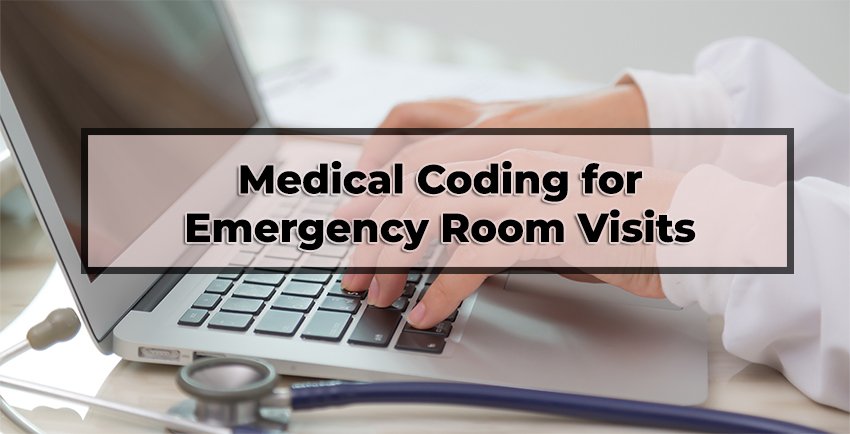Medical Coding for Emergency Room Visits
Emergency room (ER) visits are critical for providing immediate care to patients suffering from severe illnesses, traumatic injuries, or life-threatening conditions. Emergency departments (EDs) offer a broad range of services, from initial assessments and diagnostics to critical interventions and treatments. These services are often delivered under time-sensitive and high-pressure conditions, making accurate documentation and coding vital to ensuring proper reimbursement and continuity of care.

Medical coding for emergency room visits is essential for accurately capturing the scope and complexity of the care provided. Coders must use a combination of CPT (Current Procedural Terminology), HCPCS, and ICD-10-CM codes to document the services performed, the diagnosis, and the medical necessity of the treatments. Proper coding also ensures compliance with payer guidelines and enables providers to be reimbursed accurately for the high-intensity care provided in the ER.
Key Components of Emergency Room Visit Coding
ER visits cover a wide range of services, from initial evaluations and diagnostics to treatment and follow-up care. Coders must ensure that each service provided during an ER visit is properly documented and billed.
1. Evaluation and Management (E/M) Services:
Evaluation and management services are central to coding ER visits. These codes reflect the complexity and intensity of the visit. CPT codes 99281-99285 are used to document different levels of E/M services, ranging from a straightforward visit (99281) to the most complex cases (99285).
Coders must carefully review the documentation to determine the appropriate level of service, considering the patient’s condition, the physician’s evaluation, and the complexity of medical decision-making.
2. Diagnostic Services:
ER visits frequently involve diagnostic tests such as X-rays, lab work, and electrocardiograms (EKGs). Coders must ensure that each diagnostic service is coded appropriately. For example, CPT code 71045 is used for a chest X-ray, while CPT code 80053 covers a comprehensive metabolic panel (CMP).
It is essential to link diagnostic codes with the relevant ICD-10-CM diagnosis codes to demonstrate the medical necessity of these tests.
3. Critical Care and Emergency Procedures:
For more severe cases, critical care services may be provided, which must be coded accurately. CPT code 99291 is used for the first 30-74 minutes of critical care, while 99292 is used for each additional 30 minutes.
Emergency procedures such as intubation, suturing, or administering life-saving medications must also be documented separately. For example, CPT code 31500 is used for emergency endotracheal intubation, and CPT code 92950 is used for cardiopulmonary resuscitation (CPR).
Special Considerations in ER Visit Coding
Emergency room coding presents several unique challenges, particularly when it comes to documenting the intensity of care and ensuring that all services provided are appropriately reflected in the medical record.
Medical Necessity and Documentation:
Coders must ensure that the documentation reflects the medical necessity of the services provided. ER visits often involve multiple layers of care, and each service must be justified based on the patient’s presenting symptoms or condition. For instance, if a patient presents with chest pain, coders must ensure that the diagnosis, such as I20.9 (unspecified angina pectoris), is clearly documented to support any diagnostic tests or treatments.
Payers may scrutinize ER visits for medical necessity, particularly when multiple tests or procedures are performed. Proper documentation can help avoid claim denials and ensure that all services are reimbursed appropriately.
Modifiers and Time-Based Coding:
ER visits often involve procedures that require modifiers to indicate special circumstances. For instance, modifier -25 can be used to indicate that a significant, separately identifiable E/M service was provided on the same day as another procedure.
Time-based coding is critical for certain services, such as critical care or observation care, where the duration of care determines the appropriate code. Coders must ensure that the time spent on each service is accurately documented to support time-based codes.
Challenges in Coding for Emergency Room Visits
One of the primary challenges in coding for ER visits is determining the appropriate level of E/M service. Coders must carefully review the medical documentation to assess the complexity of the case, the physician’s evaluation, and the resources used. Errors in coding the level of service can lead to undercoding (and lost reimbursement) or overcoding (and audits or penalties).
Another challenge is capturing the full scope of services provided in the ER. ER visits often involve multiple interventions, tests, and follow-up care, all of which must be coded separately. Ensuring that every service is documented and coded properly is essential for accurate billing and reimbursement.
Best Practices for Accurate ER Visit Coding
Thorough Documentation of Medical Decision-Making: Coders should work closely with healthcare providers to ensure that the complexity of the medical decision-making process is clearly documented. This documentation is crucial for justifying the level of E/M service and for coding any additional procedures or tests performed during the visit.
Accurate Use of E/M Codes: Coders must carefully select the correct E/M code based on the complexity of the visit. Review the patient’s condition, the evaluation performed, and the decision-making process to choose the appropriate code.
Ensure Proper Documentation of Procedures and Tests: Every test, diagnostic procedure, and intervention performed during the ER visit must be documented clearly and coded separately. This includes everything from blood tests to imaging and critical care services. Coders should ensure that no service is missed in the documentation.
Medical coding for emergency room visits is a vital aspect of healthcare, capturing the high-intensity, often life-saving care provided in the ER. Coders must document each service accurately, from evaluation and management to diagnostic tests and critical care interventions. Using the appropriate CPT, HCPCS, and ICD-10-CM codes, coders ensure that providers are reimbursed for the care delivered in the fast-paced, demanding environment of the emergency department.
As ER visits involve a wide range of services, coders must stay informed about payer-specific guidelines, documentation requirements, and coding best practices. With careful attention to detail and thorough documentation, coders can help support the delivery of efficient, effective emergency care while ensuring compliance with billing regulations.

